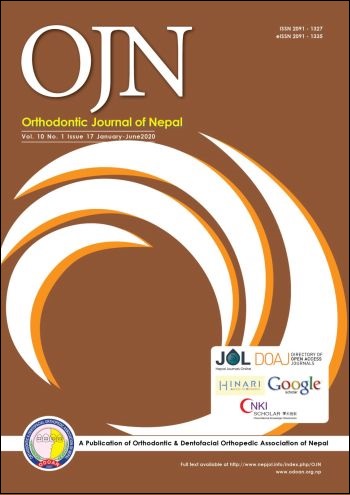Dental Inclination and Thickness of The Alveolar Bone Around Incisors and Molars According to the Vertical Facial Type
DOI:
https://doi.org/10.3126/ojn.v10i1.31000Keywords:
Alveolar bone thickness, Cone Beam, Tooth inclination, Vertical facial typeAbstract
Introduction: The teeth are incline differently according to the vertical skeletal typology and the corresponding alveolar bones do not always have the same thickness. However, the conflicting results in the literature, mainly related to the classification of patients according to vertical characteristics, creates a challenge for the clinician in determining the characteristic inclinations of teeth in a specific patient. The objective of this study was to find out dental inclination and thickness of the alveolar bone around incisors and molars in different facial type.
Materials & Method: The sample included 51 CBCT radiographs (28 females and 23 males) and subdivided into three subgroups according to vertical facial skeletal pattern (22 normodivergent subjects, 06 hypodivergent subjects and 23 hyperdivergent subjects). Reformatted CBCT images were used to measure the thickness of the vestibular and lingual alveolar bone around the incisors and first molars at two levels of root length (apical and middle) and their inclination. The Kruskal-Wallis test for the comparison of more than 2 means was applied for statistical analysis.
Result: Alveolar bone thickness in the apical region of the lingual side in hyperdivergent subjects was thicker than in the other two groups. The bone wall is thicker in the lingual than in the vestibular, regardless of the vertical skeletal typology. These varied inclinations were more pronounced anterior sector.
Conclusion: Dental inclinations have close relationships with the alveolar bone thicknesses associated with them. The apex of the root of the lower incisor is closer to the lingual alveolar crest when it was inclined in the lingual direction. There is a significant association between bone thickness around the teeth and facial skeletal divergence.
Downloads
Downloads
Published
How to Cite
Issue
Section
License
Copyright © held by Orthodontic & Dentofacial Orthopedic Association of Nepal
- Copyright on any research article is transferred in full to the Orthodontic & Dentofacial Orthopedic Association of Nepal upon publication in the journal. The copyright transfer includes the right to reproduce and distribute the article in any form of reproduction (printing, electronic media or any other form).
- Articles in the Orthodontic Journal of Nepal are Open Access articles published under the Creative Commons CC BY License (https://creativecommons.org/licenses/by/4.0/)
- This license permits use, distribution and reproduction in any medium, provided the original work is properly cited.




